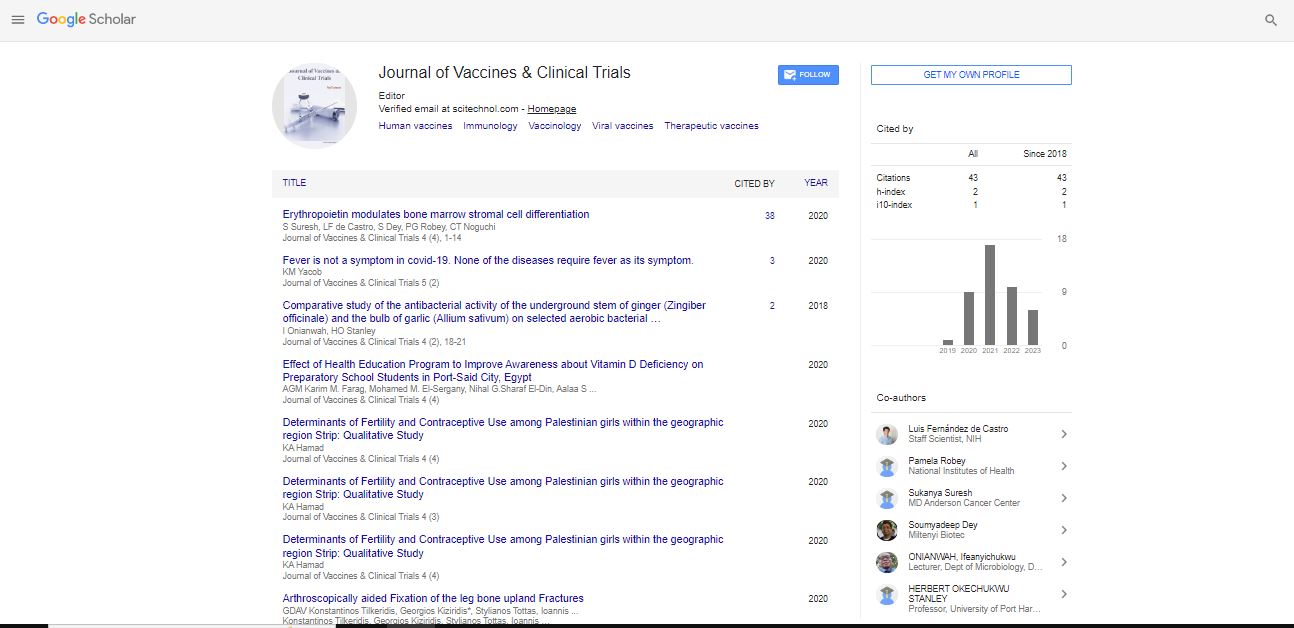Opinion Article, Jou Of Vac Cli Tr Vol: 7 Issue: 1
Bacterial Biothreat Agents: Infectious Agents
Joel Casandra*
1Department of Microbiology, Islamic Azad University, Tehran, Iran
*Corresponding Author: Joel Casandra
Department of Microbiology, Islamic Azad University, Tehran, Iran
E-mail: joeliandra@gmail.com
Received date: 24 February, 2023, Manuscript No. JVCT-23-92726;
Editor assigned date: 28 February, 2023, PreQC No. JVCT-23-92726(PQ);
Reviewed date: 13 March, 2023, QCNo JVCT-23-92726;
Revised date: 21 March, 2023, Manuscript No. JVCT-23-92726 (R);
Published date: 30 March, 2023, DOI: 10.4172/JVCT.100060.
Citation: Casandra J (2023) Bacterial Bio Threat Agents: Infectious Agents. Jou of Vac Cli Tr 7:1.
Description
Bacteria are one of the oldest and most diverse forms of life on Earth. While most bacteria are harmless or even beneficial, there are some strains that can pose a serious threat to human health. These bacterial bio threat agents are capable of causing infections that can range from mild to severe, and in some cases, even life-threatening.
Bio threat agents can be classified into three categories based on their ability to spread and cause harm: i) Category A, ii) Category B, and iii) Category C. Category A agents are the most dangerous and have the potential to cause a public health emergency. These agents include bacteria such as anthrax, plague, and botulism. Category B agents are moderately easy to spread and cause moderate illness. Examples of category B bacterial agents include brucellosis and Q fever. Category C agents are emerging pathogens that could potentially be engineered for intentional use in bioterrorism.
Anthrax is one of the most well-known Category A bacterial bio threat agents. It is caused by the spore-forming bacterium bacillus anthracis and is primarily a disease of herbivorous animals. However, humans can contract anthrax through exposure to infected animals or their products, such as wool or hides. Ingesting or inhaling anthrax spores can lead to severe illness or death. In recent years, there have been several documented cases of bioterrorism involving anthrax spores, including the 2001 anthrax attacks in the United States.
Plague is another category A bacterial bio threat agent. It is caused by the bacterium Yersinia pestis and is primarily a disease of rodents. Humans can contract plague through bites from infected fleas or through exposure to infected animals or their products. Plague can manifest in several different forms, including bubonic, septicemic, and pneumonic. Pneumonic plague is the most severe and can be spread from person to person through respiratory droplets. Without prompt treatment, plague can be fatal.
Botulism is a rare but serious illness caused by the bacterium clostridium botulinum. It is primarily a foodborne illness that can result from eating improperly canned or preserved foods. Botulinum toxin is one of the most potent toxins known to man and can cause muscle paralysis and respiratory failure. In some cases, botulism can be fatal.
Brucellosis is a category B bacterial bio threat agent that is caused by several different species of the bacterium brucella. It is primarily a disease of animals, but humans can contract the disease through exposure to infected animals or their products, such as unpasteurized milk or cheese. Brucellosis can cause a range of flu-like symptoms, including fever, headache, and muscle pain.
Q fever is another category B bacterial bio threat agent that is caused by the bacterium coxiella burnetii. It is primarily a disease of animals, but humans can contract the disease through exposure to infected animals or their products, such as contaminated dust or soil. Q fever can cause a range of symptoms, including fever, headache, and muscle pain. In severe cases, it can lead to pneumonia or hepatitis.
Conclusion
Bacterial biothreat agents pose a serious threat to human health and have the potential to cause public health emergencies. While there are several different categories of biothreat agents, category A agents are the most dangerous and have the potential to cause the most harm. It is important for public health officials to remain vigilant and prepared for the possibility of a bioterrorism attack involving bacterial biothreat agents. This includes developing and implementing strategies for early detection, rapid response, and effective treatment. By working together, we can help to ensure the safety and well-being of our communities in the face of this invisible enemy.
 Spanish
Spanish  Chinese
Chinese  Russian
Russian  German
German  French
French  Japanese
Japanese  Portuguese
Portuguese  Hindi
Hindi 